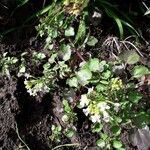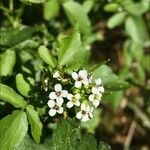Plants glabrous throughout or sparsely pubescent. Stems 1-11 (-20) dm. Cauline leaves: petiole not winged, base auriculate; blade 3-9(-13)-foliolate, (1-) 2-15(-22) cm; lateral leaflets sessile or petiolulate, rachis not winged, blade smaller than terminal; terminal leaflet (or simple blade) suborbicular to ovate, or oblong to lanceolate, (0.4-)1-4(-5) cm × (3-)7-25(-40) mm, base obtuse, cuneate, or subcordate, margins entire or repand, apex obtuse. Fruiting pedicels divaricate or descending, straight or recurved, 5-17(-24) mm. Flowers: sepals 2-3.5 × 0.9-1.6 mm; petals white or pink, spatulate or obovate, 2.8-4.5(-6) × 1.5-2.5 mm, (base to 1 mm), apex rounded; filaments 2-3.5 mm; anthers 0.6-1 mm. Fruits (0.6-)1-1.8(-2.5) cm × (1.8-)2-2.5(-3) mm; ovules (28-)36-60 per ovary; style 0.5-1(-1.5) mm. Seeds biseriate, reddish brown, ovoid, (0.8-)0.9-1.1 (-1.3) × (0.6-)0.7-0.9(-1) mm, coarsely reticulate with 25-50(-60) areolae on each side. 2n = 32.
A perennial herb with creeping or floating stems, rooting at the nodes and without a taproot. Stems hollow, glabrous or puberulous in the axils of the branches. Leaves pinnate with 3-9 leaflets, petiolate; petiole glabrous or puberulous, auriculate with lanceolate spreading auricles; lateral leaflets elliptical, dark green, entire or repand; terminal leaflet elliptical to broadly ovate-circular. Racemes terminal, dense in flower. Petals about 4 mm long, spathulate. Racemes sublax in fruit, the pedicels wide-spreading or ± reflexed, usually c. 1 cm long but up to 2 cm. Siliquae 1.3-1.8(-2) cm long, often curved-ascending; valves very weakly 1-nerved, eventually bulged by the seeds. Seeds 30-51 cm each locule; seed-coat minutely reticulate.
A cabbage family herb. It is a small leafy plant that grows in water and lasts for several years. It grows 30 cm high and has runners 2.5 m long. It has hollow stems and roots freely from the nodes. It branches freely. The leaves consist of 3 to 7 pairs of small leaflets then a larger leaflet at the end. The flowers are small and white and grow grow in a cluster. Flowers are not always produced and need days with more than 12 hours of sunlight to form. A small narrow curved seed pod about 2 cm long can develop. It grows attached to the banks of streams.
Caulescent perennial herb, up to 0.6 m high. Leaves pinnate. Racemes terminal. Flowers white.













